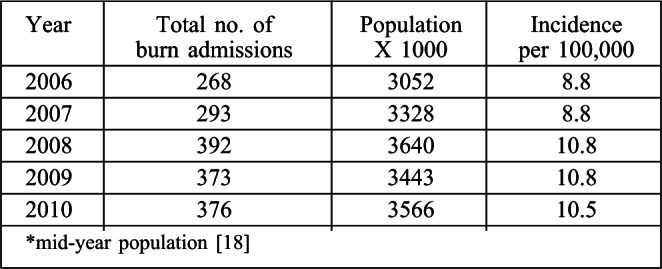Epidemiology and outcome of burns at the Saud Al Babtain Burns, Plastic Surgery and Reconstructive Center, Kuwait: our experience over five years (from 2006 to 2010)
Affiliations
Affiliations
- Saud al Babtain Burns, Plastic and Reconstructive Centre, Kuwait.
31 December 2012
Abstract
Aim To determine the epidemiology and clinical presentation, and any contributing factors responsible for burns and outcome of care in Kuwait over the 5-yr period January 2006 to December 2010. Patients and methods. The study reviewed 1702 burn patients admitted over the study period to the Saud Al Babtain Burns, Plastic and Reconstructive Surgery Center, Kuwait. Patient characteristics, including age, sex, type of burn, nationality, total body surface area (TBSA) burn, hospital stay in days, and mortality were recorded. Results. Seventy-one per cent of the 1702 burn patients admitted were males; 540 were children. The majority of patients (64%) had less than 15% TBSA burns and only 14% had more than 50% TBSA burns. Flame burns were the most common cause of burn injuries (60%), followed by scalds (29%). Scalds were most common in children. The mortality rate was 5.75%. Flame burn was the leading cause of mortality. Lethal dose 50 (% TBSA at which a certain group has a 50% chance of survival) for adults (16-40 yr) and for the elderly (>65 yr) was 76.5% and 41.8% TBSA respectively. Conclusion. Burn injury is an important public health concern and is associated with high morbidity and mortality. Flame and scald burns are commonly a result of domestic and occupational accidents and they are preventable. Effective initial resuscitation, infection control, and adequate surgical treatment improve outcomes.
Keywords: LD50 for burns in Kuwait; burns in Kuwait; epidemiology of burns; paediatric burns in Kuwait.
Figures
Similar articles
Septicaemia in scald and flame burns: appraisal of significant differences.
Bang RL, Sharma PN, Bang S, Mokaddas EM, Ebrahim MK, Ghoneim IE.Ann Burns Fire Disasters. 2007 Jun 30;20(2):62-8.PMID: 21991071 Free PMC article.
Paediatric burns in Kuwait: incidence, causes and mortality.
Sharma PN, Bang RL, Al-Fadhli AN, Sharma P, Bang S, Ghoneim IE.Burns. 2006 Feb;32(1):104-11. doi: 10.1016/j.burns.2005.08.006. Epub 2006 Jan 6.PMID: 16406370
Burn septicaemia in Kuwait: associated demographic and clinical factors.
Bang RL, Sharma PN, Sanyal SC, Bang S, Ebrahim MK.Med Princ Pract. 2004 May-Jun;13(3):136-41. doi: 10.1159/000076952.PMID: 15073425
Iron burns: a problem in adults as well as children.
Chipp E, Pape S.Ann Burns Fire Disasters. 2013 Dec 31;26(4):171-4.PMID: 24799845 Free PMC article. Review.
Epidemiology of major burns at the Lebanese Burn Center in Geitawi, Lebanon.
Ghanimé G, Rizkallah N, Said JM.Ann Burns Fire Disasters. 2013 Jun 30;26(2):59-62.PMID: 24133397 Free PMC article. Review.
Cited by
Shehab ME, Saleh LM, Isa HM.World J Plast Surg. 2022 Mar;11(1):125-131. doi: 10.52547/wjps.11.1.125.PMID: 35592231 Free PMC article.
Mobayen M, Farzan R, Dadashi A, Rimaz S, Aghebati R.Ann Burns Fire Disasters. 2017 Sep 30;30(3):189-192.PMID: 29849521 Free PMC article.
The epidemiology of burns in Basra, Iraq.
Al-Shamsi M, Othman N.Ann Burns Fire Disasters. 2017 Sep 30;30(3):167-171.PMID: 29849517 Free PMC article.
Lethal Area 50 in Patients with Burn Injuries in North West, Iran.
Mirza Aghazadeh A, Lotfi M, Ghahramanian A, Ahadi F.J Caring Sci. 2018 Mar 1;7(1):53-58. doi: 10.15171/jcs.2018.009. eCollection 2018 Mar.PMID: 29637058 Free PMC article.
Amissah NA, Buultjens AH, Ablordey A, van Dam L, Opoku-Ware A, Baines SL, Bulach D, Tetteh CS, Prah I, van der Werf TS, Friedrich AW, Seemann T, van Dijl JM, Stienstra Y, Stinear TP, Rossen JW.Front Microbiol. 2017 Oct 6;8:1906. doi: 10.3389/fmicb.2017.01906. eCollection 2017.PMID: 29056927 Free PMC article.


